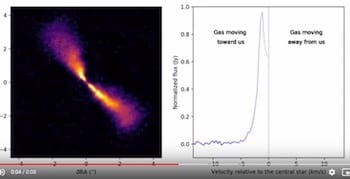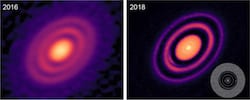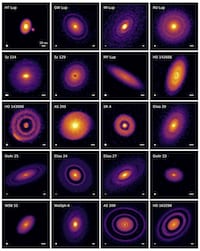NEWS RELEASE
Editor’s note: Links to video and high-resolution images for download appear at the end of this release.
David Ruth
713-348-6327
david@rice.edu
Mike Williams
713-348-6728
mikewilliams@rice.edu
Common ground discovered in planet-forming disks
Rice University astronomer leads large effort to advance theories of how solar systems develop
HOUSTON – (Dec. 12, 2018) – A distant star surrounded by a protoplanetary disk of dust and gas has given up more of its secrets to a team led by a Rice University astronomer. And it’s in good company.
Rice astronomer Andrea Isella proposed several years ago to mount a major study of disks observed around stars at the Atacama Large Millimeter/submillimeter Array (ALMA), the world’s most advanced radio telescope, on the high plains of Chile. The disks are believed to be the raw feedstock around young stars for planetary systems like our own solar system.
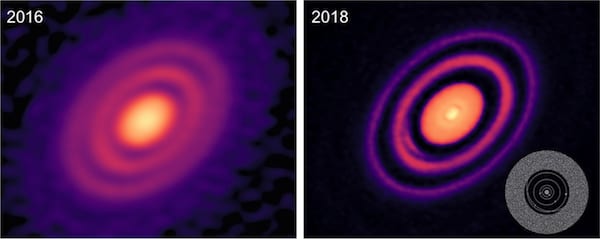
Images taken several years apart of HD 163296, a star nearly 350 light years away and seen over the Southern Hemisphere, show how improvements in the quality of images at the ALMA radio telescope have revealed new features of its protoplanetary disks. A Rice University astronomer has authored a paper explaining some of the features as part of a major survey of 20 young stars with planet-forming disks. The inset at bottom right compares the size of the disk to our own solar system. Courtesy of Andrea Isella/DSHARP/ALMA
Today, the large-scale initiative Isella began with three other principal investigators is bearing fruit.
A set of discoveries about how planets form will be the focus of a special issue of Astrophysical Journal Letters in which an international team of scientists, their students and colleagues report seeing similarities in the features of the protoplanetary disks that surround many stars. ALMA made it possible to see these features for the first time with its ability to isolate the light emitted by dust and gas in specific bandwidths and at its highest resolution.
The researchers have released 10 papers to the public, via arXiv.org, in advance of publication. In the papers, they analyze the data from 20 stars and their disks studied by the Disk Substructures at High Angular Resolution Project (DSHARP). Gathering the data took more than 50 hours of observation, an effort that began more than two years ago. That open-access data will reveal more about the systems over time as scientists dig through it, but the initial results are surprising, Isella said.
While Isella co-authored each paper, his primary contribution was in the search for new features in a star nearly 350 light years away known as HD 163296, the subject of two of his previous works. ALMA’s peak resolution reveals new structures inside its disk, which is opaque to the eye through an optical telescope.
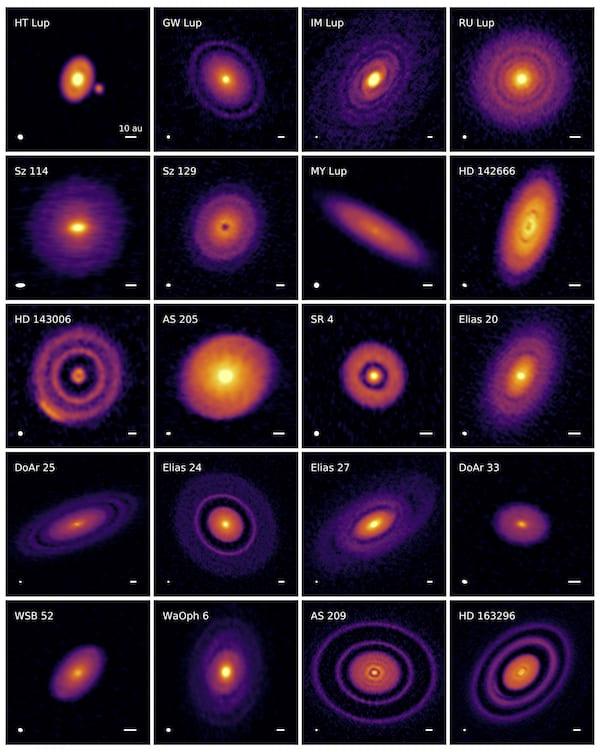
Rice University astronomer Andrea Isella and his co-principal investigators have issued the first results from a major study of protoplanetary disks observed around stars at the Atacama Large Millimeter/submillimeter Array, the world’s most powerful radio telescope in the high plains of Chile. The new data gathered over hours of observation of the 20 target stars revealed they share common features like bright and dark rings, but no two are alike. Courtesy of Andrea Isella/DSHARP/ALMA
Isella’s second study, published in 2016, was the first to map the gases in three dark rings enveloped by the dust cloud. At the time, it was one of only three protoplanetary disks featuring rings of dust that ALMA had captured. “HD 163296’s disk was already known and observed with low angular resolution, meaning the images were not that good and we didn’t see any features,” he said.
Isella said the new data shows an additional gap that was not visible in the 2016 image of HD 163296. “The innermost dust gap is at 10 astronomical units (AU), the distance from the center of our sun to the Earth,” he said. “And there’s a bright ring at 15 AU. Increasing the astronomical resolution allows us to get closer to the star, and the gap we can now see is at about the orbital radius of Saturn.
“We also barely see a feature that’s even closer, where there may be an even smaller cavity at about 4 AU, which takes us to the scale of Jupiter,” Isella said. “We are getting down to being able to see objects at the scale of our solar system.” The middle of the three previously known rings also shows a crescent-shaped cloud of dust and gas, the cause of which remains unexplained, he said.
The long-held theory of planet formation is that specks of dust and gas begin to come together into planetary embryos that eventually coalesce into planets. Evidence from DSHARP appears to show that large planets like Saturn or Neptune can form faster and much farther away from their host star than current theory allows, according to the researchers.
“We picked the rest of the 20 disks in this project because – with the exception of a couple – older images didn’t show us any features at all,” Isella said. “So the question was, did we not see features because the images weren’t good enough or because there aren’t any?”
Those features include dark rings amid the bright dust that may (or may not) be cleared by developing planets, and areas within the dust bands that are denser than others where planetary seeds may be starting to form. “When we observed the systems at higher resolution, they all showed rings,” Isella said. “That was a surprising result. It means that these structures are ubiquitous, at least among this population of disks.
“So were the three original objects an anomaly? No,” he said. “But there’s a caveat. In order to see these features, we had to pick bright objects. We weren’t looking at typical disks. It’s like saying you want to look at the average height of human beings, but you can only see the tallest ones. That is a bias of your selection.”
The researchers also wanted to know if structures within each disk were the same. The images clearly showed they aren’t. For instance, Isella and Erik Weaver, a graduate student in his Rice group, are co-authors of a study led by Harvard graduate student Jane Huang that shows the properties of the observed dust rings randomly vary from object to object and do not correlate with such physical properties as the temperature and luminosity of the central star or the amount of material in the protoplanetary disk.
Isella hopes to widen the survey to hundreds of dimmer stars thought to harbor protoplanetary disks. That will require much more time with ALMA or a much larger telescope.
“The ultimate question is whether we can see the formation of a planetary system like the solar system,” he said. “Can we see the formation of an Earth-like planet? We know how to get there: ALMA was the first step, and the next step is either to expand ALMA or build something like the (New Mexico-based) Very Large Array, but 10 times bigger.”
Co-principal investigators of DSHARP with Isella are Sean Andrews, an astronomer at the Harvard-Smithsonian Center for Astrophysics, Laura Pérez of the University of Chile and Cornelis Dullemond of Heidelberg University. All are co-authors of the paper led by Isella, along with Huang and David Wilner of the Harvard-Smithsonian Center; Tilman Birnstiel of Ludwig-Maximilian University, Munich; Shangjia Zhang and Zhaohuan Zhu of the University of Nevada, Las Vegas; Viviana Guzman of the Joint ALMA Observatory and Pontifical Catholic University of Chile; Xue-Ning Bai of Tsinghua University, Beijing; Myriam Benisty of the University of Chile; John Carpenter of ALMA; and Rice alumnus Luca Ricci of California State University, Northridge.
Research in Isella’s lab was supported by NASA and the National Science Foundation.
-30-
Read the paper at https://arxiv.org/abs/1812.04047
Follow Rice News and Media Relations via Twitter @RiceUNews.
Related materials:
Planet Formation and Circumstellar Disks (Isella group): http://planetformation.rice.edu
ALMA: https://www.eso.org/public/usa/teles-instr/alma/
Rice Department of Physics and Astronomy: https://physics.rice.edu
Wiess School of Natural Sciences: https://naturalsciences.rice.edu
Video:
Images captured by the ALMA radio telescope show a sweep of the HD 163296 protoplanetary disk to look for carbon monoxide and its velocity as it travels around the star. Carbon monoxide molecules located on the left side of the image move toward Earth, as revealed by the Doppler shiftof their emission, while molecules on the other side of the image move away. The motion of carbon monoxide molecules reveals the rotation of the disk and in turn helps reveal properties of dust within the disk that were impossible to see until now. (Credit: Andrea Isella/DSHARP/ALMA)
Images for download:
https://news2.rice.edu/files/2018/12/1217_PLANETS-1-WEB-1ss3tqv.jpg
Images taken several years apart of HD 163296, a star nearly 350 light years away and seen over the Southern Hemisphere, show how improvements in the quality of images at the ALMA radio telescope have revealed new features of its protoplanetary disks. A Rice University astronomer has authored a paper explaining some of the features as part of a major survey of 20 young stars with planet-forming disks. The inset at bottom right compares the size of the disk to our own solar system. (Credit: Andrea Isella/DSHARP/ALMA)
https://news2.rice.edu/files/2018/12/1217_PLANETS-2-WEB-23q80bg.jpg
Rice University astronomer Andrea Isella and his co-principal investigators have issued the first results from a major study of protoplanetary disks observed around stars at the Atacama Large Millimeter/submillimeter Array, the world’s most powerful radio telescope in the high plains of Chile. The new data gathered over hours of observation of the 20 target stars revealed they share common features like bright and dark rings, but no two are alike. (Credit: Sean Andrews/DSHARP/ALMA)
https://news2.rice.edu/files/2018/12/1217_PLANETS-3-web-20saeij.jpg
Rice University astronomer Andrea Isella is co-principal investigator on the Disk Substructures at High Angular Resolution Project to analyze protoplanetary structures around 20 young stars. Initial results by the international team of scientists were published this week. (Credit: Jeff Fitlow/Rice University)
Located on a 300-acre forested campus in Houston, Rice University is consistently ranked among the nation’s top 20 universities by U.S. News & World Report. Rice has highly respected schools of Architecture, Business, Continuing Studies, Engineering, Humanities, Music, Natural Sciences and Social Sciences and is home to the Baker Institute for Public Policy. With 3,962 undergraduates and 3,027 graduate students, Rice’s undergraduate student-to-faculty ratio is just under 6-to-1. Its residential college system builds close-knit communities and lifelong friendships, just one reason why Rice is ranked No. 1 for lots of race/class interaction and No. 2 for quality of life by the Princeton Review. Rice is also rated as a best value among private universities by Kiplinger’s Personal Finance. To read “What they’re saying about Rice,” go to http://tinyurl.com/RiceUniversityoverview.

